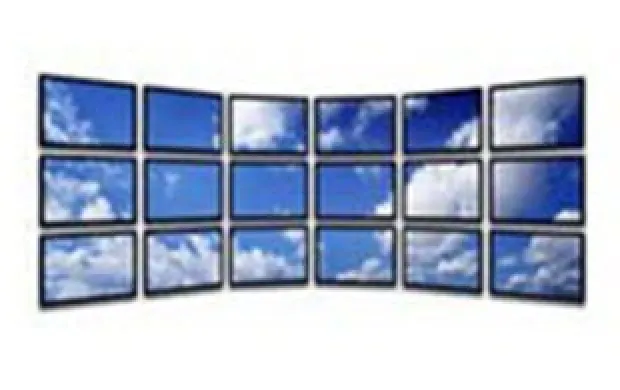Televisions
For PartnersWhy ENERGY STAR?
From binge-watching a big budget series to late night gaming marathons, today's televisions are a cornerstone of home entertainment. Any activity that increases screen time means increased energy use in the home, making it more important than ever to choose an energy efficient, ENERGY STAR certified television. With nearly as many TVs as people in the U.S., individual changes can add up to a big difference.
ENERGY STAR certified televisions are, on average, 25 % more energy efficient than conventional models, saving energy in all usage modes: sleep, idle, and on. The ENERGY STAR label can be found on TVs with the latest "must-have" features, including:
- High dynamic range (HDR) for brighter highlights, a wider range of colors, and better contrast levels.
- Internet connectivity, also referred to as "Smart TVs" (for access to streaming video services like Netflix or Hulu).
- Ultra-high definition (UHD) resolution, 4 times as many pixels as conventional high definition TVs, for crystal clear and life-like images.
In addition to purchasing an ENERGY STAR certified television, you should be aware of the other ways to save energy while watching TV:
- Learn how to configure your game console to operate in the most efficient way possible.
- Learn what devices are best for stream your favorite shows efficiently.

Rebate Finder
Our partners sponsor rebates on certified products.
What features are important to consider?
Today’s TVs come with many bells and whistles, and this can be overwhelming when shopping for a new model. In addition to looking for the ENEGY STAR label, here are a few other things you might want to consider when purchasing a new television:
Picture Quality
- Ultra-High Definition (UHD), also known as “4K,” is the new standard. UHD TVs, with 3,840 x 2,160 resolution, provide you with great detail and richer, life-like images and have become the new standard resolution for TVs. Nowadays, high definition (HD) TVs, with 1920 x 1080 resolution, are typically offered at deep discount. Streaming services, cable TV and satellite TV now all offer 4K content. (Please note: as of 2019, an 8K TV is very expensive with very limited content available.)
- High Dynamic Range (HDR) is the next big thing. HDR offers brighter highlights, wider range of colors, and better contrast levels. HDR TV shows are available on streaming services. HDR comes in numerous formats, including HDR10, Dolby HDR, HDR10+, and others.
- Organic Light Emitting Diode (OLED) TVs provide the best picture and use less energy but are expensive. Most TVs today use light-emitting diodes (LEDs) to illuminate a liquid crystal display (LCD) screen. OLED TVs do not use an LED backlight but instead use millions of individual OLED pixels that each create light on its own. The result is that you can have much, much thinner screens and better contrast and black levels achieved by turning pixels completely off. OLEDs also use less energy than LCD screens. However, OLED TVs may not be as bright as LED LCD TVs and will cost you much more money.
- Refresh Rate should be at least 120 times per second. Refresh rate tells you how many times per second (also known as “Hertz”) your picture is refreshed. 60 Hertz can lead to a jittery or blurry image. Look for TVs with at least a 120 Hertz refresh rate.
Convenience
- Smart TVs are going way beyond streaming. While they are known for connecting to Wi-Fi and streaming videos through services like Netflix or Hulu, Smart TVs are expanding their capabilities to include playing games, connecting to social media, and controlling your home’s other connected devices. Many have voice recognition tools for use with Amazon Alexa or Google Assistant or for switching channels and searching for other programs. Be sure you compare the different Smart TV interfaces for ease of use, number of available apps, and how often they are updated. In addition, Smart TVs are the most efficient way to stream—avoiding the extra energy use of a game console or digital media player.
- Look for at least four HDMI plugs. The number of HDMI inputs is an easily overlooked feature of a television set up but is crucial for your overall TV experience. Accommodating just standard elements of an entertainment system, like a game console, a sound bar, and a cable box, requires 3 HDMI inputs. Make sure to look for the number that is right for you.
Energy Efficiency
- Automatic Brightness Control (ABC) saves energy and enhances the viewing experience. The ABC feature is a self-acting mechanism that controls the brightness of the TV relative to the brightness of the room in which it is located.
- Local Dimming saves energy and gives deeper blacks. Local dimming turns off or dims sections of the LED backlighting to help produce truer black levels.
- ENERGY STAR picture settings optimize your energy efficiency. TVs are now shipping with pre-set picture views such as "vivid," "sports," or "cinema." Look for the pre-set picture settings with the ENERGY STAR label to ensure energy savings.
What size TV is right for me?
Picking the correct size television for your space is important to your overall viewing experience and will stretch out the length of time between upgrades. While you don’t want to buy too small and cause dissatisfaction and eye strain, bigger is not always better. Here are a few tricks to get your TV size right the first time.
- Viewing distance. Measure your viewing distance and divide by 2 to get the recommended UHD TV diagonal length. Your room size, furniture set up, and personal preference will dictate how close you sit to the TV.
- Line of sight. Ideally your television height will be parallel with your eyes, and no higher or lower than 15 degrees. Depending on your decision whether to mount your television to the wall, your space may dictate what size TV can fit at the right angle.
How do I improve sound?
Although providing spectacular picture quality, today’s flat screen TVs have gotten so thin that the speaker drivers can’t be much bigger than those in a good pair of headphones. This results in a tiny sound with inferior bass prone to distortion at high volume. One simple way to improve your TV viewing experience is to invest in a sound bar—a slim row of speakers that sit inconspicuously beneath your TV and deliver louder, higher quality audio. Many offer features such as wireless streaming, built-in voice assistance, and surround sound. Most importantly, many models are ENERGY STAR certified and are up to 70% more energy efficient than conventional models.
When should I buy a TV?
The best times to buy a TV are:
- Super Bowl Season (January and February). Not only is the biggest football game of the year an ideal excuse to sell the latest TVs, current models will have been out for a year by February, and there will be a natural decrease in prices.
- Spring. This is when new TV models are released and models from last year are discounted with closeouts extending into summer.
- Black Friday and Cyber Monday. According to Consumer Reports, some televisions sell for 50% off during Black Friday. Be aware that some manufacturers create special TV models for Black Friday and Cyber Monday, referred to as “derivatives”, comparable to current models but lacking certain features. If a model number search does not come up with reviews or is not sold anywhere else, it may be a derivative.
Be sure to look for the ENERGY STAR when shopping for a television
Current Specification Effective Date: March 1, 2019
Televisions originally qualified for the ENERGY STAR label in 1998. ENERGY STAR certified televisions must consume 0.5 watts or less in Sleep Mode and On Mode power requirements vary according to screen area. External power supplies (EPS) packaged with TV products must meet level VI performance requirements under the International Efficiency Marking Protocol and include the level VI marking.

Your go-to resource for the latest advice from ENERGY STAR experts on saving energy at home and work.
RELATED PRODUCTS
Join Mailing List
Sign up for newsletters from ENERGY STAR to help you save money and energy at home.






